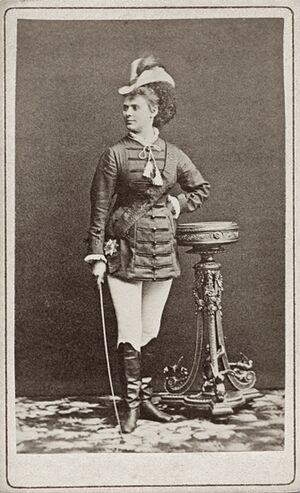Djurgårdsteatern



Djurgårdsteatern (English: The Djurgården Theatre) was a theatre on Djurgården, an island then outside of the city of Stockholm, active between 1801 to 1929.
History[1]
In 1795, Abraham de Broen (1759–1804), actor at the Royal Dramatic Theatre, asked for the permission to build and run a theatre. A theatre-privilege was given to himself, his wife and their children for as long as they wished to use it. De Broen did not make use of the privilege right away, as he was still employed at the Royal Stage and therefore would not have been allowed to act at his own theatre. It was only a few years later, when he resigned from his position due to issues with his memory, that he decided to take build the theatre.[2]
In 1798, a new theatre monopoly was stated, which banned all theatres except the royal ones inside the city border of Stockholm.
When Djurgårdsteatern was opened in 1801, however, it was located on Djurgården, at the time an island outside the city itself, and furthermore, it was not what was counted as a "real theatre"; it was what was called a "summer theatre", active only in summers (from 1 May until 1 October),[3] and often called "the summer stage". Thereby, it did not threaten the royal monopoly.
The staff at the theatre was described as "former footmen and maids", indicating that most of the performers were amateurs.
However, it was also often used as a stage for traveling theatre troupes passing through Stockholm. Also, many of the actors from the Royal Dramatic theatre and the Royal Swedish Opera made guest performances, making their débuts and started their careers here. The actors at Djurgårsteatern also toured on the country side. It was described as a smaller, more informal and less high pitched theatre.
After the death of Abraham de Broen, it was managed by his widow Maria Elisabeth Grundt and his son, actor Isaac de Broen. Christina Margareta Cederberg took over the theatre after the death of her husband Isaac in 1814, until she passed on the leadership of the theatre to Karl Wildner, the husband of her sister-in-law, in 1815.
In the 1830s, Djurgårdsteatern entered a new age when it was the place of the abolishment of the royal theatre privilege in Stockholm. After the great theatre strike on the Royal Dramatic theatre by the actor couple Ulrik Torsslow and Sara Torsslow in 1834, the Torsslow couple left the royal theatre along with many other stars, who started to perform the Djurgårdsteatern in summer and in Kirsteinska huset, a concert house, in winter. The director of the Djurgården theatre, Isaac de Broen's brother-in-law Karl Wildner, married to Debora Aurora de Broen, then transferred the old theatre privilege of the de Broen-family on Torsslow and Pierre Deland, who worked on abolishing the old theatre regulation. In the 1841–1842 season, Torsslow stated, that he would start to play on Djurgårsteatern in the winters as well, no matter if he was stopped or not, and as the government did not wish to stop him, the old regulation was formally abolished in 1842. This quickly led to the establishment of several new theatres, such as Mindre teatern (or Nya teatern) in 1842, Södra teatern (1852) and Ladugårdslandsteatern (1856).
Theatre Building


The first building was ready in 1801, and was refered to as "spektakelladan" (spectacle-barn) or "baraquen" (the barrack) due to its primitive nature. The architecture was simple as were the materials that were mostly donated, such as planks from wrecked ships and other thrown away material.[4] The theatre was built in a hurry, as there were rumors of a circus director with plans to also play theatre – a possible competitor to de Broen and his privilege to erect and manage a theatre.[5]
In 1863, Djurgårdsteatern burnt down, and the de Broen's privilege was abolished, but it was rebuilt again in 1866-67 and continued with its activity until it burnt down again in 1929.
Performances
The theatre opened for the first time on 17 June 1801. The opening programme consisted among others of Foyern by Mårten Altén and Den sköna Rosette eller Tidens seger (The fair Rosette or The Victory of Time) by Marc Antoine Legrand.
On 28 June, Märta Helena Reenstjerna, also known as Årstafrun (The Årsta Lady), visited the theatre. She watched both the latter mentioned play by Legrand, as well as a performance of Goldoni's commedia dell'arte play Två herrars dräng (The Servant of Two Masters). Den självkäre (Narcisse) by French enlightenment philsopher Jean Jaques Rousseau was also performed.
For an incomplete list of performances from 1841 onwards, please refer to:https://sv.wikipedia.org/wiki/Djurgårdsteaterns_uppsättningar
Directors[6]
- 1801-1804: Abraham de Broen
- 1804-1809: Maria Elisabet de Broen (widow of Abraham)
- 1809-1814: Isaac de Broen (son of Maria Elisabet)
- 1814-1815: Christina Margareta Cederberg (widow of Isaac)
- 1815-1835: Karl Wildner (married to Isaac's sister Debora Aurora de Broen)
- 1835-1837: Pierre Deland (Isaac's son-in-law)
- 1835-1849: Ulrik Torsslow (1835-37 jointly with Deland)
- 1849-1861: Pierre Deland (second term)
References
- ↑ https://en.wikipedia.org/wiki/Djurgårdsteatern
- ↑ Ullberg, Hans: Djurgårdsteatern. En teaters historia 1801-1929, Stockholm: Höjerings, 1993, p. 9.
- ↑ Ullberg, Hans, Djurgårdsteatern: en teaters historia 1801-1929, Höjerings bokförlag, Stockholm, 1993, p. 9.
- ↑ Ullberg, Hans, Djurgårdsteatern: en teaters historia 1801-1929, Höjerings bokförlag, Stockholm, 1993, p. 9-10.
- ↑ Ullberg, Hans, Djurgårdsteatern: en teaters historia 1801-1929, Höjerings bokförlag, Stockholm, 1993, p. 10.
- ↑ https://en.wikipedia.org/wiki/Djurgårdsteatern
- Ullberg, Hans, Djurgårdsteatern: en teaters historia 1801-1929, Höjerings bokförlag, Stockholm, 1993

